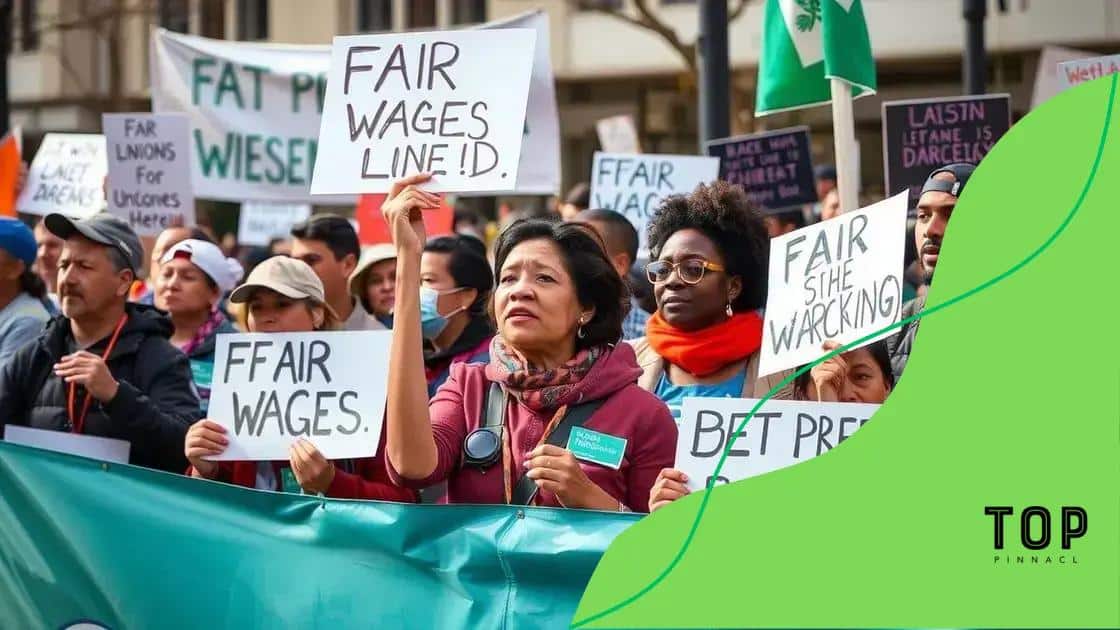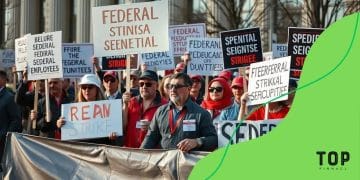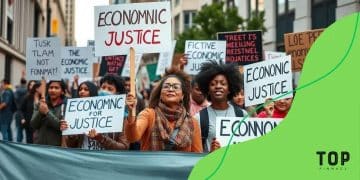Labor union response to wage stagnation: a new approach
The labor union response to wage stagnation includes collective bargaining, grassroots mobilization, and strategic advocacy to secure fair wages and improved working conditions for workers in a changing economic landscape.
The labor union response to wage stagnation is reshaping how workers advocate for fair pay. Have you noticed how stagnant wages can impact your daily life? This article uncovers unique strategies and perspectives that unions are employing today.
Understanding wage stagnation
To truly grasp the issue at hand, we must first understand wage stagnation. This term describes the situation where workers experience little to no increase in their wages over time, despite increases in productivity and the cost of living. Many individuals find themselves in a challenging position, wondering why their salaries are not keeping pace with inflation and economic growth.
Wage stagnation can be caused by various factors, including shifts in the job market and changes in economic policy. Governments and businesses can play a significant role in shaping wage trends. When examining this phenomenon, it’s essential to consider the impact of globalization and technological advancements on wages.
Factors Contributing to Wage Stagnation
Several elements contribute to wage stagnation:
- Global competition: Increased competition from countries with lower labor costs can pressure companies to keep wages down.
- Technological changes: Automation and technology can displace workers, limiting their ability to negotiate higher pay.
- Weak labor unions: A decline in union power can lead to reduced bargaining strength, negatively affecting wage increases.
Aspects such as the gig economy have also shifted traditional employment, making it crucial for workers to adapt to new market conditions. Even though some sectors see growth, many employees still struggle to achieve a stable income.
Consequences of Wage Stagnation
The repercussions of wage stagnation can be profound, affecting not only individuals but also the economy as a whole. When workers cannot keep up with rising living costs, they may turn to credit, leading to increased debt.
- Decreased purchasing power: Wages that do not increase can diminish workers’ ability to afford necessary goods and services.
- Economic inequality: A wider gap between high earners and low earners can result, creating social and economic disparities.
- Reduced economic growth: When people have less money to spend, consumer demand drops, which can slow down the economy.
Understanding the complexities surrounding wage stagnation is vital for both workers and policymakers. By addressing these challenges head-on, labor unions aim to negotiate fair wages and improve working conditions for all employees.
Historical perspective on labor unions
The historical perspective on labor unions reveals their vital role in advocating for workers’ rights. Understanding their evolution helps us appreciate why they are crucial today. Labor unions began as grassroots movements in the late 19th century, growing out of a need for collective bargaining.
During the Industrial Revolution, workers faced harsh conditions, long hours, and minimal pay. In response, they organized to seek better working environments. This marked the inception of labor unions as a powerful force in the workplace. As workers banded together, they could negotiate salaries, benefits, and safe working conditions.
Key Milestones in Labor Union History
Here are some significant moments that shaped labor unions:
- The formation of the American Federation of Labor (AFL) in 1886, which united various skilled trades to strengthen labor’s voice.
- The Wagner Act of 1935, which supported workers’ rights to unionize and engage in collective bargaining.
- The establishment of the Congress of Industrial Organizations (CIO) in 1935, focusing on uniting workers across different industries.
As the years progressed, labor unions fought against injustices and pushed for important reforms, including the establishment of the 40-hour workweek and health benefits. In the post-World War II era, labor unions reached their peak, representing a significant percentage of the workforce. They became a powerful political force, influencing legislation and economic policies.
The Decline of Union Membership
Despite their success, union membership began to decline in the late 20th century due to various factors. Changes in the economy, such as the shift to service industries and the rise of globalization, presented challenges. Additionally, changes in labor laws made it more difficult for new unions to form. This decline has raised concerns about the protection of workers’ rights.
Today, labor unions continue to adapt and respond to new challenges. They focus on issues like wage stagnation and the gig economy, striving to remain relevant in a changing landscape. The historical perspective on labor unions is essential for understanding their ongoing relevance and the challenges they face in advocating for workers.
Effective strategies from unions

Labor unions have developed various effective strategies to tackle wage stagnation and advocate for workers’ rights. These strategies not only help to improve wages but also ensure better working conditions. By organizing and empowering workers, unions create a collective strength that can bring about significant change.
One key strategy that unions use is collective bargaining. This process allows workers to negotiate as a group with their employers, leading to better pay and benefits. Unions gather data on industry standards to make informed demands, ensuring their members receive fair compensation. Through collective bargaining, unions can also negotiate essential workplace protections and policies.
Grassroots Mobilization
Another important approach is grassroots mobilization. Unions encourage members to participate actively in campaigns, rallies, and discussions. This not only raises awareness about wage issues but also fosters solidarity among workers. Engaging in community outreach helps unions to gain support from the public and demonstrate the importance of fair wages.
- Building alliances: Forming partnerships with other organizations can strengthen campaigns.
- Utilizing social media: Modern unions leverage platforms to communicate effectively and inspire action.
- Organizing strikes: Strikes can bring attention to wage stagnation and pressure employers to negotiate.
In recent years, unions have also started focusing on digital organizing. Utilizing technology, they can reach younger workers and those in non-traditional employment sectors. This method includes using apps to connect with members, share resources, and mobilize collective actions.
Advocacy and Legislation
Unions play a crucial role in advocating for legislation that benefits workers. By lobbying for policies that raise the minimum wage or enforce employee protections, they help to shape the economic landscape. They also educate members about their rights and the political processes that impact wages.
The work unions do in these areas is vital in the fight against wage stagnation. As they adapt to changing times and economic conditions, their strategies continue to evolve, focusing on strengthening labor rights and ensuring that workers are compensated fairly.
Case studies of successful interventions
Examining case studies of successful interventions can provide valuable insights into how labor unions effectively combat wage stagnation. By looking at real-world examples, we can better understand the tactics unions have employed to achieve meaningful change for workers.
One notable case is the unionization of the hotel and restaurant industry in major cities like New York. Unions played a crucial role in advocating for fair wages and improved working conditions. They organized strikes and negotiations that led to better contracts. These efforts resulted in significant wage increases for many workers, demonstrating the power of collective action.
The Fight for Higher Wages in Retail
Another compelling example comes from the retail sector, particularly with the movements in large companies like Walmart. Workers organized protests and campaigns to demand higher wages and better treatment. Through persistent pressure, the union was able to secure wage increases, which set a precedent for similar businesses to follow.
- Establishing minimum wage laws: Unions advocated for local government policies that increased the minimum wage.
- Creating awareness: Campaigns brought public focus to worker struggles and built community support.
- Negotiating with corporations: Unions held discussions at corporate levels to ensure that worker needs were met.
In the healthcare sector, unions have also achieved success by negotiating contracts that provide better salaries and benefits for nurses and support staff. Their ability to effectively lobby for legislative changes allowed many healthcare workers to see substantial increases in their pay and improved working conditions.
Impact of Digital Campaigns
Recently, many unions have utilized digital campaigns to advocate for wage increases. For example, the Fight for $15 movement effectively used social media to mobilize support and raise awareness about the need for higher wages in fast-food jobs. This movement not only influenced public perception but also led to actual wage increases in several states.
These case studies highlight the effectiveness of unions in advocating for better pay and working conditions. By using strategic organizing, creative campaigns, and community support, they have made a significant impact on wage stagnation issues.
Future outlook for labor and wages
The future outlook for labor and wages is a topic of great significance, especially as we navigate a rapidly changing economy. Several emerging trends have the potential to reshape how labor is viewed and compensated. Understanding these factors can help workers and unions prepare for the coming changes.
One major trend is the rise of technology and automation in the workplace. As machines and software become more capable, many jobs may evolve or become obsolete. This shift can lead to increased efficiency, but it may also create wage stagnation for lower-skilled positions. Workers will need to adapt by acquiring new skills relevant to the modern job market.
Focus on Fair Wages
Another critical aspect is the growing demand for fair wages. The movement for a higher minimum wage continues to gain momentum across various sectors. Many workers now advocate for not just better pay, but also benefits that support a decent standard of living. This push reflects a broader societal shift towards valuing labor more appropriately.
- Increased unionization: More workers are seeking union representation to negotiate better wages and conditions.
- Legislative changes: Advocacy for laws that support wage increases and better worker protections is becoming more prominent.
- Corporate responsibility: Businesses may feel more pressure to address wage issues due to consumer demand for ethical practices.
Additionally, the gig economy is reshaping the workforce. More individuals are taking on freelance and contract jobs, which often come with less stability and fewer benefits. This trend raises questions about how labor can be valued in these new work structures. As gig work becomes commonplace, fair compensation and access to benefits will remain hot topics for discussion.
Education and Training
In response to these changes, there is a growing emphasis on education and training. Workers who invest in skills development will likely be better positioned to command higher wages. Unions and organizations are responding by providing resources and programs that enhance job training and professional growth.
Overall, the future outlook for labor and wages will be shaped by the intersection of technology, social movements, and education. As these elements evolve, they will influence how workers negotiate their worth in the ever-changing economic landscape.
FAQ – Frequently Asked Questions about Labor Unions and Wage Stagnation
What are labor unions?
Labor unions are organizations that represent workers in negotiations with employers to secure better wages, benefits, and working conditions.
How do unions help with wage stagnation?
Unions advocate for fair wages and work to negotiate better contracts, which can lead to increases in pay for their members.
What is collective bargaining?
Collective bargaining is the process where unions negotiate with employers on behalf of workers to reach agreements on wages and working conditions.
Why is fair compensation important?
Fair compensation is crucial for maintaining a decent standard of living for workers, promoting fairness, and supporting economic stability.






